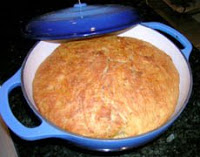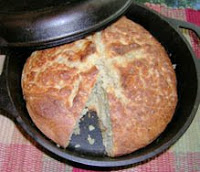 A frequent question buyers of no-knead bread books like my Kneadlessly Simple have is what kind of pot works best for the loaves baked in pots? In the entry here, I mentioned that suitable baking containers include Dutch ovens, soup pots, some deep casseroles and even large, deep, oven-proof saucepans. Tallish, 9-inch diameter containers in the 3 1/2- to 4-quart range will yield particularly nicely-shaped loaves; larger ones will do, but the breads spread too much.
A frequent question buyers of no-knead bread books like my Kneadlessly Simple have is what kind of pot works best for the loaves baked in pots? In the entry here, I mentioned that suitable baking containers include Dutch ovens, soup pots, some deep casseroles and even large, deep, oven-proof saucepans. Tallish, 9-inch diameter containers in the 3 1/2- to 4-quart range will yield particularly nicely-shaped loaves; larger ones will do, but the breads spread too much.
Beyond these basics, the specific type or brand of pot needed depends largely on your personal preferences and situation. A tight budget, or limited kitchen storage space, or need for an all-purpose pot, or one that’s lightweight, or attractive enough to serve meals in, or even a preference for very well browned or only lightly colored breads all affect what’s “right” for you. BTW, if you’ve got a pot you love (or hate) I’d love you to leave a comment about it here.
Metal Matters
Pots made of plain cast iron, enamel-coated cast iron, enamel-coated steel, anodized aluminum, enamel-coated aluminum, copper, plain stainless steel, and stainless steel with a aluminum or copper core can all be used so long as the handles, knobs, etc., tolerate 450 degrees F. Avoid glass or ceramic casseroles for Kneadlessly Simple pot breads—many recipes call for thoroughly preheating the container at high temperatures, and glass or ceramic can crack from heat stress. Additionally, breads tend to stick to these surfaces but release from metal pots because they contract a good deal as they cool. Tip: For the rare metal pot that doesn’t release breads easily, spray it with nonstick spray just before the dough gets turned out into it.
Each metal has a different look and feel and unique cooking properties that can immediately narrow your choices. For example, for a readily luggable, liftable pot, you’ll need to choose among stainless steel, anodized aluminum, or enamel-coated aluminum or steel; enamel-coated or plain cast iron are H-E-A-V-Y! If you must have a truly all-purpose cooking/baking pot, you’ll require either a non-reactive stainless steel or anodized aluminum model or one that’s enamel-coated on the inside; plain aluminum, copper, iron, or carbon steel all react with acids and won’t do for many dishes.
Here’s a quick rundown of your heavyweight options. I’ll talk about the lightweight bread pots in a follow-up blog entry soon. Though they are less often used, I’ve found they can do a good job and have some significant advantages. One of my cheapest, most durable, and handiest bread pots is in this category, so check back for the details.

 Plain uncoated cast iron is very heavy and conducts and holds heat evenly. It bakes bread well and browns loaves very thoroughly (too thoroughly for some cooks). Uncoated iron has a dark, plain-looking finish that must be seasoned before use or bought already pre-seasoned (which I highly recommend). The metal reacts with acids, so can’t be used to cook acidic dishes (containing wine, tomatoes, fruits, etc.), must be dried thoroughly to avoid rusting, and is never dishwasher safe. Uncoated pots range from dirt cheap to fairly inexpensive, yet are durable and sturdy; drop ‘em and you are as likely to break your countertop, tile floor, or foot as the pot!
Plain uncoated cast iron is very heavy and conducts and holds heat evenly. It bakes bread well and browns loaves very thoroughly (too thoroughly for some cooks). Uncoated iron has a dark, plain-looking finish that must be seasoned before use or bought already pre-seasoned (which I highly recommend). The metal reacts with acids, so can’t be used to cook acidic dishes (containing wine, tomatoes, fruits, etc.), must be dried thoroughly to avoid rusting, and is never dishwasher safe. Uncoated pots range from dirt cheap to fairly inexpensive, yet are durable and sturdy; drop ‘em and you are as likely to break your countertop, tile floor, or foot as the pot!
The first plain pot is a pre-seasoned Lodge Logic Combo Cooker; it was bargain priced, well made, and bakes my breads nicely. The pot on the right is a fairly well-constructed, durable Asian knockoff camp-style Dutch oven (brand unknown) that does the job, but tends to over-brown loaves a bit. (You can compensate for this tendency by lowering the baking temperature 25 to 50 degrees F.)
Enamel-coated cast iron not only conducts heat beautifully but boasts a hard, glossy, completely non-reactive and rust-resistant finish (in many attractive colors) that makes for a good multi-purpose cooking/serving container. If you don’t want your breads to brown deeply, be sure the interior is a light color.
 Prices range from relatively inexpensive for knockoffs to breathtakingly expensive for French “gourmet” brands. Well-constructed versions are durable and long lasting; poorly made models may deteriorate quickly as the enamel pits, cracks, chips off, or, yikes! peels away in chunks. Pricey, top-of-the-line French brands such as le Creuset (a 15-year-old pot is pictured here) and Staub will last a lifetime. My beautiful blue moderately-priced Lodge Colors (purchased two years ago and shown at the very top) performs well, looks carefully constructed and is holding up nicely, though there’s one tiny chip on the rim. (I swapped out the original heat-sensitive knob for a pretty metal one.) Other less expensive brands that many reviewers rate as remarkably durable and good quality for the price include the 3.5 quart Tramontina (available only via Walmart’s catalog), which is also carried by Target (usually via catalog) sometimes under the Chef-mate label, and the Mario Batali 4-quart Essentials Dutch oven.
Prices range from relatively inexpensive for knockoffs to breathtakingly expensive for French “gourmet” brands. Well-constructed versions are durable and long lasting; poorly made models may deteriorate quickly as the enamel pits, cracks, chips off, or, yikes! peels away in chunks. Pricey, top-of-the-line French brands such as le Creuset (a 15-year-old pot is pictured here) and Staub will last a lifetime. My beautiful blue moderately-priced Lodge Colors (purchased two years ago and shown at the very top) performs well, looks carefully constructed and is holding up nicely, though there’s one tiny chip on the rim. (I swapped out the original heat-sensitive knob for a pretty metal one.) Other less expensive brands that many reviewers rate as remarkably durable and good quality for the price include the 3.5 quart Tramontina (available only via Walmart’s catalog), which is also carried by Target (usually via catalog) sometimes under the Chef-mate label, and the Mario Batali 4-quart Essentials Dutch oven.
Like my Lodge Colors and le Creuset, many enameled pots come with phenolic knobs that can’t withstand oven temps above 400 degrees F. Le Creuset now sells a heat-resistant replacement knob (for $10!), but any $2 nickel, brass or stainless steel knob purchased from a hardware store will do the job just as satisfactorily and likely looks more stylish.

The Lodge Color is a 3 quart. It is big enough for most loaves because the top is slightly domed and they can expand up into it. If you like your bread lighter, it will be a better choice than the Logic.
Which size of Lodge Color dutch oven do you have? Amazon shows a 3 quart and a 4.5 quart.
I was going to purchase the Lodge Logic combo, but we like our bread lighter.
That's interesting. I didn't know about the replacement knobs you could buy.